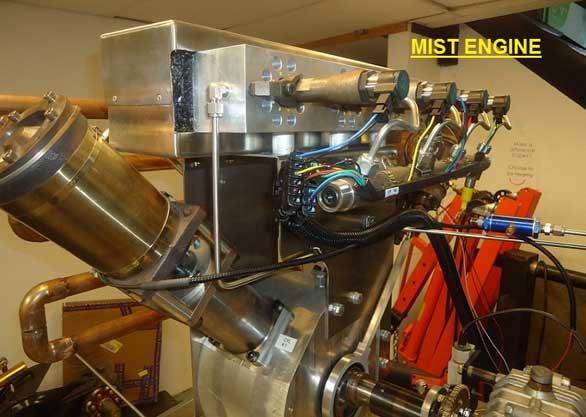High pressure water/steam system releases hydrogen bonds, produces excess energy
Richard Aho of MIST Energy Systems has been working for years on the idea that hydrogen bond energy could be harnessed. He went on working where others had abandoned the field because they knew it "couldn't be done".

In his Mist Energy System, water is pressurized by a commercially available high pressure pump, it is then released through a nozzle into an impact chamber, where the jet hits a metal target. Heat is released and the water instantly transforms into steam. The energy spent to pressurize the water and pre-heat the impact chamber is about one tenth of the energy contained in the steam that is produced. That is a 10:1 over-unity factor, achieved with nothing but available tech and water as a medium.
See a more detailed explanation in Hydrogen Bond Explosions
Of course steam is what has been driving our electricity-producing machines for a long time. The heat is usually supplied by burning carbon fuels like coal, oil or gas. Even atomic power plants are little more than very expensive - and rather dangerous - steam engines fired by the heat of radioactive elements.
So if we could make the needed steam without recourse to carbon based or atomic fuels, would that not be a giant step forward?
I believe it would, and the technology is available.
What are we waiting for?
- - -
THE ENGINE
MIST, which is an acronym for Molecular Impact Steam Technology, has patented a new system for creating energy. The energy is derived from the heat produced by molecules of water impacting at hypersonic speed on a hard surface inside an 'impact chamber'. Rest haven shown that the energy contained in this high impact "dry" steam exceeds by multiples, the man-made energy required to run the system.
"The key word here is "man-made". We are not trying to say we are creating energy out of nothing. What we are doing is capturing the release of the energy holding the molecules of water together. Using a modified diesel injector, we were able to inject minute amounts of high-pressure droplets of water into the impact chamber. Upon impact the molecules of water literally explode causing them to increase in temperature and pressure."
A patent application for this technology is pending.
Any free energy investors out there who are interested?
The basic technology is proven and well in hand.
It needs to be scaled up and made commerce ready to start replacing some of our current polluting energy sources in power plants ...
More information is available on the mistenergysystems.com site.
Here is a video of an early test with temperature measurements.
Richard Aho's comment to the video:
1. First we turn off heaters, no source of heat or energy now.
2. We turn on the injectors 5 injections a second, 300 a minute
3. You can hear each explosion, then you can see the steam,
from hydrogen bond explosions
4. Look at the internal heat on digital thermocouple, from
Impact Heating, besides making 200 psi steam from
each injection, the Impact Heat has to maintain operating temperature
for the system.
After 5 minutes and 5 seconds, we have 1,525 injections, 1,525 explosions
and the thermocouple inside the heater has cooled down to 306 degrees F.
But the internal heat ( steam and surface temperature inside) is still 381 degrees F - exactly what you expect for 195 psi steam.
This is a historic event.
THE ENERGY COMES FROM IMPACT HEATING.
Some details on the energy accounting (energy in - energy out) from a recent (August 1013) email message of Richard Aho.
We are using a hydraulic accumulator to store the hydraulic oil [used to run the injectors] at 3,000 psi for this test.
The hydraulic pump formula world wide is 1 h.p pumps 1 gallon per
minute at 1500 PSI.. This is linear and as we use 3,000 psi our formula is 1 h.p pumps 1/2 gallon per minute..
Our test at 300 injections per minute is 3.1 oz per minute of water.
Our injector has a intensifier piston 5 to 1 .. so we use 15.5 oz
of [the stored] hydraulic oil a minute. ( 15,000) psi.
In 1 hour we convert 12 lbs of water into 195 PSI steam,
The average electric steam generator uses 1,169 BTU
per pound.. Our output per hour is 14,028 btu
Input energy is 12 times our intensifier ratio of 5 to 1
or 60 lbs of hydraulic oil at 3,000 psi.
This equals 1/8 GPM. or 1/4 h.p 186.5 watts per hour
or 635.965 BTU.
1 hp times 1 GPM is 480 GPH for 746 Watts.
1 hp times 1/2 GPM is 240 GPH at 3,000 psi is also 746 watts
1 hp times 1/4 GPM is 120 GPH at 3,000 psi is 373 watts.
1 hp times 1/8 gpm is 60 GPH at 3,000 psi or 186.5 watts per hour
This is the mechanical formula, except for any energy
used to heat the feed water. In Florida it was 80 BTU per pound
12 pounds times 80 is 960 BTU added to 635.965 total
1,595.965 BTU
Thermal energy output per hour 14,028 BTU Exceeds
Mechanical energy Input of 1,595.965 BTU.
This is 8.789 to 1 over unity.
This more recent video shows what appears to be a hydrogen ignition of the stream of steam exiting the impact chamber's exhaust nozzle. (at 15 sec into the video)
https://www.youtube-nocookie.com/watch?v=9Qb_M-h7UAw&feature=youtu.be





Paramahamsa Tewari comments by email:
"I see this phenomenon as follows: Pressurised water brings molecules closer. High velocity impact on a metal target will break chemical bonds between Hydrogen molecules and oxygen atoms, releasing electrons and ionising the water volume. Charged Hydrogen and Oxygen atoms combine again due to their structural forces and produce heat but without any loss in their structural forces. This effect should be termed as " Chemical Fusion" of H and O to form water molecule.In fact cold fusion is also a Chemical Fusion."
Michael Riversong says (in email):
"Run the steam through a Tesla Turbine. I saw a guy in Dallas do that in 1995 and it worked really well. He could put out a fire using about 1/10th of the water ordinarily needed."
Ummm. No. The enthalpy of formation of hydrogen bonds is about -20 kJ/mol or about -1,110 kJ/kg. Energy is released when these bonds FORM, it ABSORBS energy to break them. The bonds are there because it's a potential energy well. The site is riddled with simple numerical errors and misapplication of physical concepts. As one example (of many), They state that 10 h.p. is 7.46 kW. So far, so good. They then divide by 60 and state that this is 124.3 watts per minute which is nonsense. They then compare this nonsense number to the calculated "power" in the steam to come up with their "overunity" number. This is just silly.
Whether contemporary science can explain the effect is really no test.
Obviously heat is produced in great quantities, providing useful, high-pressure steam.
So the hydrogen bond releases energy when it is formed, and absorbs when it is ruptured. Perhaps what we see is a mechanical rupturing of the hydrogen bond by the high pressure impact, and a heat production when the molecules re-form immediately afterwards.
No one has measured the mechanical stress needed to break hydrogen bonds - it's usually done with electricity, by electrolysis. We know how much that absorbs, but mechanical rupturing of the bonds? It's an idea that hasn't been tried before. So who's to say it doesn't work in a more economic way than what we usually do.
Granted, the input-output accounting will have to be done properly, to satisfy the critics, but the margin of excess energy in the steam with regard to the energy put in to produce that steam is great enough to be of good hopes, even with a rough calculation...
Why make just supersteam when you can make oxydrogen on demand using mechanical method? Changing an little your method you are able to make electrolisys of water by impact using an triboelectric catalyst. This idea isn't new. Some old scientists are working on thousands years ago one of these is Michael Faraday. In all cases this is the right way to go.
Thank you Al Nenc,
I think the effect you mention is actually being found with the working machinery. They have to fiund a way to control it and then yes - it could be a whole different use of the technology with hydrogen as the outcome, instead of just the heat.
In any case, it is a neat new way of beating the second law...
Surely isn't the same reaction. You are able to make electricity at the same time? What appear really inside your chambre??
you are near to reach final reaction but actually I think you are reaching only supersteam condition. Mechanical impact on catalyst can be new method for make the oxyhydrogen mixture without use electricity because that born inside the same process.
Water droplets are the way for make an independent energy source. You don't need high pressure pumps when you can make steam in old way. When mechanically you are able to split hydrogen bonds you obtain free electrons .. in electrolisys you obtain H2 from H3O+ adding free electrons source.. if you are able to make plasma mechanically on triboelectric metal you are able to make acquire also free electrons and hydrogen appear and burn at the same time..
I find the calculations contained in the linked document titled "Hydrogen Bond Explosions" more reliable than them in the main article. I confirmed by going through the steam tables, that the saturated steam of temperature 576 Fahr has an absolute pressure of 1285,74 psi and an enthalpy of 1180,9 BTU per lb.The enthalpy, as the technical thermodynamic teaches us, is the exploitable energy of the system and its ambient. In the case of the test, it is what we can drain from the produced steam in terms of heat and mechanical work. Producing the same steam under the conventional way by offering heat, the heat we give transforms exactly to enthalpy.
Is the law of conservation of energy violated? Well, no. If the chemical bonds between hydrogen molecules and oxygen atoms is broken it consumes energy, mechanical energy, but energy. When charged Hydrogen and Oxygen atoms combine again to form water, they produce energy in thermal form. If the measurements and calculations of the document are right as it seems, then the produced water in steam form must have a different structure in molecular and crystal scale. This water must be unable to recycle and generate energy anew. It would be interesting if they tried this experimentally. Even so we are on the eve of new discoveries on the nature of water. Water as combustible? It is a historical breakthrough!
Allow me a little more exact calculations. The enthalpy of about 1181 BTU/lb is the heat required to transfer 1 lb of water from 32 degrees F to the condition of 576 F saturated steam. Just to heat the water from 32 F to 160 F requires 126 BTU/lb. So the procedure of impact heating generated 1181-126=1055 BTU/lb of water. We payed 90 BTU/lb to heat the water from its natural condition of 68 F (20 degrees C) to 160 F.
The rest runs as in the linked document, a little modified to the worse. That is 1055-90-47=918 BTU/lb= 918/108=8.5 BTU/(4.2 grams) net energy profit of the experiment. Or (918/90)*100= 1020 percent.
actually (918/137)*100=670 percent
Analyzing your engine I don't understand why you want generate steam and power piston engine indirectly instead to created the rection directly on engine chambre on head of piston.. you lost many energy in this step.. if now you obtain 10 an efficiency after you can obtain 100 or more.. in all case continue to use the piston for me isn't the right solution